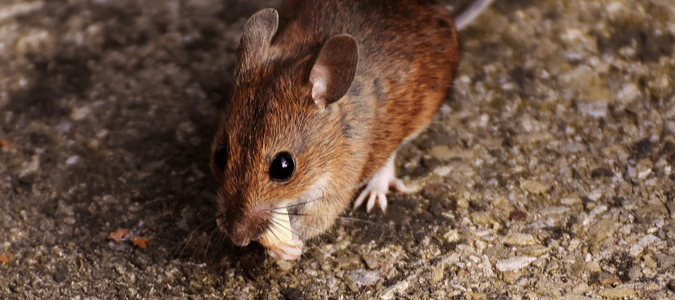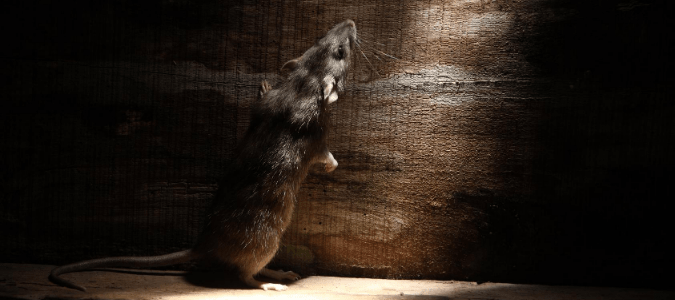
People often think that mice are only active at night because they usually spot them or hear them at night. In reality, you can see a mouse any time of day. Mice have just evolved to be more active at night because there are typically fewer dangers for them after the sun goes down. For example, in the wild, mice learned there were fewer predators out when it was dark, so this was the ideal time to go searching for food. This same principle can be applied to mice that are living inside your home. Once you turn off the lights and everyone heads to bed, including your pets, there’s a better chance for mice to find food and build their nests without putting themselves in harm’s way.
However, there are reasons that you might see a mouse out during the day. These rodents may be traveling to a place where there isn’t usually much movement in daylight hours. For instance, movie theaters and bars typically have fewer customers during the day, so mice might be more active in the middle of the day in these types of places.
Another reason that mice might come out in the daytime is if they’ve found a travel route between their nest and food that’s usually safe. These rodents eat several times each day—and sometimes as often as 20 times in a 24-hour period. You might see a mouse around your home if it’s looking for food, trying to escape an area that’s become dangerous or trying to find shelter.
If you believe you might have a mouse problem, but you’re not entirely sure, you should know that these creatures typically leave behind evidence that you can keep an eye out for. For example, you might see gnawing on your furniture or bite marks on a bag of pet food. Some other typical signs of a mouse or rodent problem include:
- droppings;
- damage to your walls, wiring, insulation or other parts of your home;
- rodent nests or signs of nesting, such as shredded paper or bundles of cotton, twigs or grass;
- alive or dead rodents;
- strange noises coming from your attic or scratching noises in your walls;
- odd smells and
- greasy track marks along baseboards and walls where mice have been traveling.
Unfortunately, pest infestations can happen at any time of the year and in any neighborhood. Additionally, it’s often difficult to tackle the problem unless you know for sure what kind of creatures you have in your home. Issues with other types of rodents and wildlife can sometimes look very similar to infestations by mice. For instance, a raccoon can get into your attic and make strange noises at night. Or, a possum may be eating the fruit from your garden. And, rat droppings look awfully similar to mouse droppings.
Just trying to identify what kind of pest you have can easily turn into a time-consuming and costly process for homeowners who don’t have extensive training and experience in wildlife control. Beyond that, control tactics for mice might not work for another kind of pest. However, a rodent control specialist can take care of everything for you—from figuring out what kind of pest is in your home to eliminating the pest infestation to helping you keep yourself from getting in this situation again. These professionals have the knowledge and skills to handle this pesky problem, so you don’t have to deal with it.
If you do, in fact, have a mouse problem, you probably have asked yourself a number of other questions, starting with how it got started.

How Are Mice Getting in My House?
Unfortunately, any space that’s the size of a dime might serve as an entry point for a mouse. Mice can get inside homes through a number of different routes, including:
- gaps under a garage door;
- spaces around cables, wiring, drains or pipes;
- openings around windows and doors;
- loose shingles;
- uncapped chimneys;
- missing bricks;
- loose vents or fans;
- worn out boards or siding and
- gaps in crawl spaces.
Some of the reasons that mice would want to get into a home include easy access to sources of food or shelter. Contrary to what some homeowners might think, however, if you have mice in your house, it doesn’t mean that your home is dirty or unkept. For example, these rodents are often drawn to things like bird seed that falls from a bird feeder, fruit in homeowners’ gardens, trash in a garbage can and food left uneaten in a dog’s bowl. Other common areas of people’s homes and yards, such as mulch piles and thick vegetation near a house, can attract mice as well.
Unfortunately, if you have one mouse, you might soon have many more. A mouse population can quickly get out of control because of the breeding habits of mice. A female mouse usually has around five or six babies in each litter, but they can have up to a dozen babies in a litter. Additionally, these rodents can have litters that are less than a month apart, and they can produce as many as twelve litters each year. No wonder mice are considered pests!
Plus, their offspring mature incredibly fast and can start having babies of their own when they’re as young as just six weeks old. This means that mice can multiply rapidly in a home and that any infestation can quickly get worse if it isn’t taken care of properly.
The best way to handle this kind of scenario is to enlist the assistance of a wildlife control specialist. Not only can these professionals deal with any mice you might currently have in your home, but they can also help reduce the risk of a future infestation.
As previously mentioned, mice can squeeze through holes the size of a dime, so it can be difficult for a homeowner to identify and then seal off all potential rodent entry points. However, a professional can use their knowledge and in-depth experience to identify potential problem areas and help make your home less vulnerable to rodents.
In addition to mice getting into attics, another problem area homeowners commonly encounter is realizing they have mice inside of their walls.

How To Get Rid of Mice in the Walls
Homeowners may try a variety of different tactics to get rid of mice in their walls. Of course, the most effective method is to prevent the problem before it even starts by sealing up any openings around your house that are bigger than a quarter of an inch.
It’s also important to use the right materials, such as wire mesh or sheet metal, when sealing these holes. This is because mice can often chew through less durable materials like caulking. Additionally, it’s critical to clear any potential food or water sources as part of your pest control plan.
For example, take the following steps to make your home less attractive to mice and other forms of wildlife:
- Only feed your dog as much as food as you know they will eat and clean any uneaten food out of the bowl as soon as your pet is done eating.
- Put a cover on your pool or hot tub when not in use.
- Keep feed for pets in rodent-proof containers.
- Pick up any fruit that drops in your garden or excess bird seed that falls from your feeder.
- Store your trash in a can with a secure lid and that’s made of metal or another sturdy material.
- Fix drainage in areas of your property where water often pools.
If you already have an infestation, one of the things that you might try to address mice inside your walls is to set traps. Some foods that mice find attractive are nuts, peanut butter, lunchmeat and gumdrops. It’s important to set traps along the rodents’ typical travel routes, such as beside a wall or fence.
However, if you choose to take a do-it-yourself approach to rodent problems, you might encounter numerous challenges. For one, if you decide to use rodent bait or poison to try to control the infestation, it’s possible that the mice will end up dying and rotting inside your wall—in a place that would be difficult for you to reach without tearing up your home, and which can put you in quite a smelly situation.
Additionally, mice can present serious health risks to your family and your pets. These rodents carry a number of diseases that they can spread to humans and other animals. Mice leave behind urine and feces that can make you sick, and they often contaminate food while they’re eating. This behavior can also have a significant impact on homeowners over time, because mice often contaminate even more food than they eat.
If you’re dealing with a mouse infestation, a wildlife control specialist can save you precious time and money. Perhaps even more important, these pros can help protect your family from these hazardous creatures. An experienced professional can help you figure out what kind of animal pest you have in your home and handle the capture and removal, so you don’t have to worry about that. These licensed professionals can take care of every aspect of rodent control for you, and they can create a comprehensive pest control plan to help you prevent additional issues from any unwanted bugs or wildlife in the future.
ABC Can Get Your Mouse Problem Under Control
Although homeowners may be able to trap a few mice here and there, it’s extremely difficult to eliminate a population without professional help. When you contact ABC Home & Commercial Services for rodent control, you can feel confident that our pros will remove these unwelcome visitors. To prevent future infestations, we offer an ongoing pest management program, so you can have peace of mind knowing that mice will no longer make your home theirs.